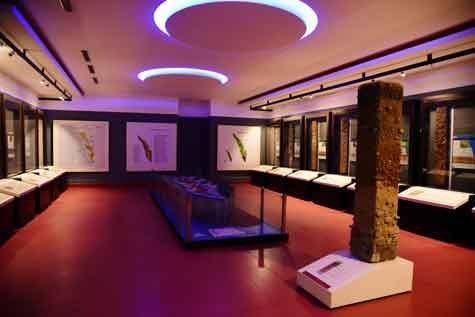
Quick Links
- Arboretum
- Bambusetum
- Cane & Palmetum
- Herbarium
- Orchidarium
- Xylarium
- Wildlife Museum
- Teak Museum
- Nature Trail
- Thematic Displays
- Medicinal Plants
- Butterfly Garden
- Insect collection
- Laboratories
- Plant Propagation
- Networks & Helpline
- Monitoring Facilities
- Centralised Facilities
Other Facilities
Other Groups
Soil museum
 The soil museum in KFRI is very unique in the sense that it showcases the diversity of soils in different types of forest ecosystems, and the reflections of degradation of natural vegetal covers on the soil beneath. Normally, there are a lot of restrictions for the general public to enter into the forests, and even if they enter, they are unable to understand what is happening below the forest floor.
The soil museum in KFRI is very unique in the sense that it showcases the diversity of soils in different types of forest ecosystems, and the reflections of degradation of natural vegetal covers on the soil beneath. Normally, there are a lot of restrictions for the general public to enter into the forests, and even if they enter, they are unable to understand what is happening below the forest floor.
Soil, the key source of life on this planet is a very dynamic and heterogeneous natural resource. The thin layer of soil above bedrock is the centre of many global issues such as food security, water security, climate change adaptations and mitigation, biodiversity protection, environmental and human health, etc. The transfer of knowledge to the general public on the significance of soil on the sustenance of life on this planet and the need for sustaining the ecosystem services they render in the changing global climatic scenario has become a major challenge. The idea of communicating and sensitising the general public on soils and their functioning through soil museums had been vested with the soil science community during the historical evolutions.
The soil museum was established as part of a research project funded by KFRI plan and was inaugurated by Dr.Suresh Das, Executive Vice President, Kerala State Council for Science, Technology, and Environment on 10 December 2015 at the opening session of a national seminar on "Issues, challenges, and strategies in sustaining soil health" hosted by KFRI during 10 - 11 December 2015, as part of celebrating the international year of soil. The forest soil museum is the first of its kind in India and provides valuable information on soil genesis and transformation in the humid tropics.
The most important exhibits in this forest soil museum are well-preserved monoliths of forest soils. A monolith is essentially a profile representing the soil typical of a region, with all the basic characteristics preserved intact. It displays vertical sections of the soil from the surface to the bedrock below displaying the various horizontal layers or genetic horizons. Alongside each monolith, is provided the information on the taxonomy, physical and chemical characteristics of the soil, forest type, and the picture of forest type and soil profiles. Any degradation of a forest ecosystem is reflected in the soil profile and the visitors to the museum are exposed to and educated on the degradation of soil due to deforestation and consequent depletion of ecosystem services, which ultimately threatens the existence of life on this planet.
Currently, there are 20 Soil monoliths in the museum with depicts the variation in morphological properties of soil beneath different forest ecosystems like evergreen forests, Shola forests, grasslands, dry deciduous forests, scrub forests, degraded forests in the Kerala part of Western Ghats. It is planned to expand the museum by displaying more monoliths from different forest types across India.
Contact: Soil museum
Kerala Forest Research Institute
Peechi P.O, Thrissur District, Kerala - 680653, India.
Tel: +91-487-2690182
e-mail: soilmuseum@kfri.res.in
